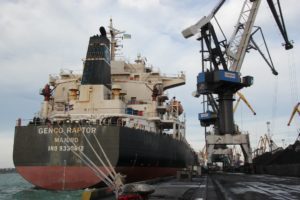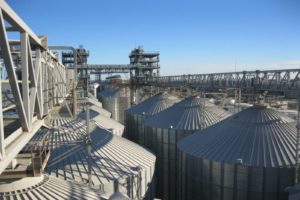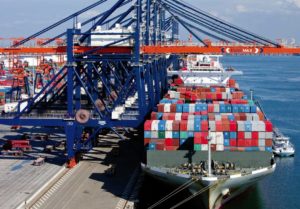
The Pivdenny Sea Trade Port in Odesa region, the largest seaport of Ukraine in terms of transshipment, increased freight transshipment by 24.31% in January-July 2019 compared to the same period of 2018, to 28.129 million tonnes.
During this period the port increased the handling of freight for export by 38.44%, to 21.405 million tonnes, but reduced the handling of imported cargo by 5.95%, to 3.623 million tonnes and the handling of transit freight fell by 6%, to 3.091 million tonnes, the Ukrainian Sea Ports Authority said.
In January-July 2019, the port increased handling of liquid freight in bulk by 7.19%, to 2.502 million tonnes, dry fright in bulk by 30.1%, to 23.015 million tonnes, and packaged freight by 0.18%, to 2.613 million tonnes. Container handling in January-July 2019 totaled to 114,545 TEU (an increase by 2.05 times compared with the same period of 2018).

Nika-Tera sea terminal (Mykolaiv) in the 2018/2019 marketing year (MY, July-June) handled 4.7 million tonnes of grain and leguminous crops, which is 88% more compared to the previous MY.
According to a report on Nika-Tera’s website, in the 2018/2019 MY the port grain transshipment items included corn (50%), wheat (34%), soybeans (8%), barley (5%), and peas (3%).
In addition, during this period, the terminal shipped 350,000 tonnes of soybeans, which is seven times more than the figure for the same period of the last marketing year.
Some 240 vessels with grain and leguminous crops were shipped for export.
During the period from July 2018 to June 2019, Nika-Tera handled 395 vessels, and the volume of transshipment amounted to 7.25 million tonnes of cargo.
As reported, in 2018 Nika-Tera seaport handled 335 vessels, transshipping 5.84 million tonnes of freight, which is 40% more than in 2017.
Nika-Tera is a modern highly mechanized marine terminal, part of Group DF’s port business.
GRAIN, LEGUMINOUS CROPS, NIKA-TERA, SEA TERMINAL, TRANSSHIPMENT

Mykolaiv seaport in January-March 2019 increased cargo handling by 26.2% compared with January-March 2018, to 8.117 million tonnes.
According to the data of the Ukrainian Sea Ports Authority, during this period the port increased the transshipment of exported cargo by 30.72%, to 6.247 million tonnes, imported cargo by 26.67%, to 1.606 million tonnes, and coastal freight handling by 12.75%, to 263,470 tonnes. The port did not transship transit cargo.
In January-March 2019, the port increased the transshipment of liquid cargo by 0.1%, to 764,830 tonnes, increased dry bulk freight by 28.1%, to 6.3 million tonnes, packaged ones by 40.32%, to 1.052 million tonnes.
As reported, Mykolaiv seaport in 2018 increased cargo handling by 24.09% compared with 2017, to 29.2 million tonnes.
Mykolaiv seaport has an area of 97.3 ha and a water area of 224.5 ha. It is connected to the Black Sea by the Buho-Dniprovsko-Lymansky canal. The port has 15 berths with a total length of 2.962 km.

Chornomorsk seaport (Odesa region) in January and February 2019 increased cargo handling by 27.32% compared with January and February 2018, to 3.993 million tonnes.
According to the Ukrainian Sea Ports Authority, in January and February 2019, Chornomorsk port increased the handling of exported cargo by 42.3%, to 3.311 million tonnes, imported cargo handling fell by 21.2%, to 521,540 tonnes, transit goods handling grew by 5.89%, to 155,900 tonnes, while the port handled 3,710 tonnes of coastal freight (no handling in January and February 2018).
Liquid cargo handling increased by 16.7%, to 269,050 tonnes, dry bulk cargo by 29.42%, to 2.67 million tonnes, packaged goods by 25.07%, to 1.053 million tonnes. Container handling amounted to 20,134 TEU (a decline of 2.97%).
As reported, the volume of transshipment in the port in 2018 rose by 25.02% compared with 2017, to 21.54 million tonnes.
Chornomorsk port is a universal international port, one of the largest on the Black Sea. The enterprise has specialized terminals and complexes, which allow overloading a wide range of goods: liquid, bulk, general. Its 29 berths are capable of receiving ships with a carrying capacity of up to 100,000 tonnes. The annual designed capacity of the port is more than 30 million tonnes.

Mykolaiv seaport in January 2019 increased cargo handling by 18.84% compared with January 2018, to 2.321 million tonnes.
According to the data of the Ukrainian Sea Ports authority, during this period the port increased the transshipment of exported cargo by 22.69%, to 1.78 million tonnes, imported cargo by 13.95%, to 491,970 tonnes, and coastal freight handling fell by 6.4%, to 47,330 tonnes. The port did not transship transit cargo.
In January 2019, the port cut the transshipment of liquid cargo by 1.12%, to 172,680 tonnes, increased dry bulk freight by 19.8%, to 1.838 million tonnes, packaged ones by 38.27%, to 310,770 tonnes.
As reported, Mykolaiv seaport in 2018 increased cargo handling by 24.09% compared with 2017, to 29.2 million tonnes.

Construction of new grain and oilseeds transshipment facilities at the Mykolaiv seaport will start in the rear of berth eight. Private investment will total over UAH 1.2 billion, the Ukrainian Sea Port Authority has reported. “We are investing our own funds and are actively cooperating with port operators and private businesses. This is the development of the berth and rear infrastructure of berths zero and eight. This will increase the capacity of the Mykolaiv port for processing grain by more than 2 million tonnes per year, oil – by 750,000 tonnes per year,” Head of the Ukrainian Sea Port Authority Raivis Veckagans said during a working visit to the Mykolaiv seaport.
The Ukrainian Sea Port Authority refused to name investors, adding that this would be a new cooperation for the port. The Ukrainian Sea Port Authority plans to allocate UAH 350 million within the framework of fulfilling the company’s obligations under a public private partnership project for the construction and dredging of berth eight. At the same time, private investment in infrastructure will amount to over UAH 1.2 billion.
According to the Ukrainian Sea Port Authority, the planned grain complex will have a storage capacity of 96,000 tonnes, a warehouse – 40,000 tonnes, as well as other support facilities. Earlier, the Infrastructure Ministry reported that COFCO (China National Cereals, Oils and Foodstuffs Corporation) is ready to invest up to $30 million in the berth capacity of the Mykolaiv port and river logistics.
Seaside Terminal intends to invest about UAH 120 million in the reconstruction of the Mykolaiv-Vantazhny railway station in order to increase its capacity.
FACILITIES, GRAIN, INVESTMENT, MYKOLAIV, OILSEEDS, SEAPORT, TRANSSHIPMENT